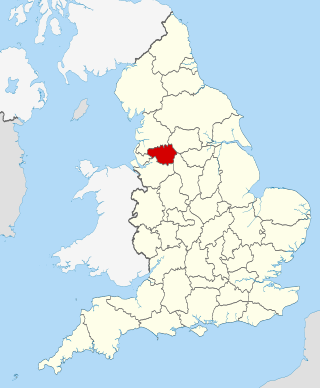
Metropolitan counties are a subdivision of England which were originally used for local government. There are six metropolitan counties: Greater Manchester, Merseyside, South Yorkshire, Tyne and Wear, West Midlands and West Yorkshire.

The counties of England are divisions of England. Counties have been used as administrative areas in England since Anglo-Saxon times. There are two main legal definitions of the counties in modern usage: the 84 counties for the purposes of local government, and the 48 counties for the purposes of lieutenancy, also termed the ceremonial counties.

Local government in England broadly consists of three layers: civil parishes, local authorities, and regional authorities. Every part of England is governed by at least one local authority, but parish councils and regional authorities do not exist everywhere. In addition, there are 31 police and crime commissioners, four police, fire and crime commissioners, and ten national park authorities with local government responsibilities. Local government is not standardised across the country, with the last comprehensive reform taking place in 1974.
In the United Kingdom, passenger transport executives (PTEs) are local government bodies which are responsible for public transport within large urban areas. They are accountable to combined authorities, which were created between 2011 and 2016 and took the role of integrated transport authorities (ITAs). The PTEs have joined together to form the Urban Transport Group, in which Transport for London and Strathclyde Partnership for Transport also participate.

Birmingham, a city and metropolitan borough in the West Midlands, England, is the second-largest city in the United Kingdom.

The Association of Greater Manchester Authorities was the local government association for Greater Manchester, a metropolitan county in North West England. Its creation followed the abolition of the Greater Manchester County Councilbeing established in 1986 as a governmental organisation to represent the ten district councils of Greater Manchester. AGMA was later superseded by the Greater Manchester Combined Authority, the first authority of this new type in the United Kingdom, on 1 April 2011.

The Local Government Act 1958 was an Act of the Parliament of the United Kingdom affecting local government in England and Wales outside London. Among its provisions it included the establishment of Local Government Commissions to review the areas and functions of local authorities, and introduced new procedures for carrying these into action.
The Passenger Transport Executive (PTE) bus operations were the bus operating divisions of the passenger transport executives in the United Kingdom. In 1986 they underwent a process of deregulation and privatisation, forming some of the largest private bus companies in the UK outside London, with all being sold to their employees or management. Despite their relative size and lucrative operating areas, none of the companies survived beyond the late 1990s, with all falling into the hands of the major bus groups, who had their origins in privatised regional subsidiaries of the former National Bus Company and the Scottish Bus Group.
The New Year Honours 2008 for the Commonwealth realms were announced on 29 December 2007, to celebrate the year passed and mark the beginning of 2008.
New Years' Honours are announced on or around the date of the New Year in Australia, Canada, New Zealand and the United Kingdom. The dates vary, both from year to year and from country to country. All are published in supplements to the London Gazette and many are conferred by the monarch some time after the date of the announcement, particularly for those service people on active duty.

The New Year Honours 2000 for the United Kingdom and New Zealand were announced on 31 December 1999, to celebrate the year passed and mark the beginning of 2000. The Honours list is a list of people who have been awarded one of the various orders, decorations, and medals of the United Kingdom. Honours are split into classes ("orders") and are graded to distinguish different degrees of achievement or service, most medals are not graded. The awards are presented to the recipient in one of several investiture ceremonies at Buckingham Palace throughout the year by the Sovereign or her designated representative. The Prince of Wales and The Princess Royal deputised for The Queen.

A combined authority (CA) is a type of local government institution introduced in England outside Greater London by the Local Democracy, Economic Development and Construction Act 2009. CAs are created voluntarily and allow a group of local authorities to pool appropriate responsibility and receive certain devolved functions from central government in order to deliver transport and economic policy more effectively over a wider area. In areas where local government is two-tier, both must participate in the combined authority.

The Greater Manchester Combined Authority (GMCA) is a combined authority for Greater Manchester, England. It was established on 1 April 2011 and consists of 11 members; 10 indirectly elected members, each a directly elected councillor from one of the ten metropolitan boroughs that comprise Greater Manchester, together with the directly elected Mayor of Greater Manchester. The authority derives most of its powers from the Local Government Act 2000 and Local Democracy, Economic Development and Construction Act 2009, and replaced a range of single-purpose joint boards and quangos to provide a formal administrative authority for Greater Manchester for the first time since the abolition of Greater Manchester County Council in 1986.

West Yorkshire County Council (WYCC) – also known as West Yorkshire Metropolitan County Council (WYMCC) – was the top-tier local government administrative body for West Yorkshire from 1974 to 1986. A strategic authority, with responsibilities for roads, public transport, planning, emergency services and waste disposal, it was composed of 88 directly elected members drawn from the five metropolitan boroughs of West Yorkshire. West Yorkshire County Council shared power with five lower-tier district councils, each of which directed local matters.

The West Midlands Combined Authority (WMCA) is the combined authority for the West Midlands metropolitan county in the United Kingdom. It was established by statutory instrument under the Local Democracy, Economic Development and Construction Act 2009. It is a strategic authority with powers over transport, economic development and regeneration. The authority formally came into being on 17 June 2016.
After extensive privatisation of the public sector during the Margaret Thatcher administration, there remain few statutory corporations in the UK. Privatisation began in the late 1970s, and notable privatisations include the Central Electricity Generating Board, British Rail, and more recently Royal Mail. After the Hatfield rail crash accident, the British government decided to intervene and in 2002 renationalised Railtrack into Network Rail.
The 2021 New Year Honours are appointments by some of the 16 Commonwealth realms to various orders and honours to recognise and reward good works by citizens of those countries. The New Year Honours are awarded as part of the New Year celebrations at the start of January and those for 2021 were announced on 30 December 2020.

The 2022 Salford City Council election took place on 5 May 2022 along with other local elections across the United Kingdom. One third—20 out of 60—of councillor seats on Salford City Council were up for election.














